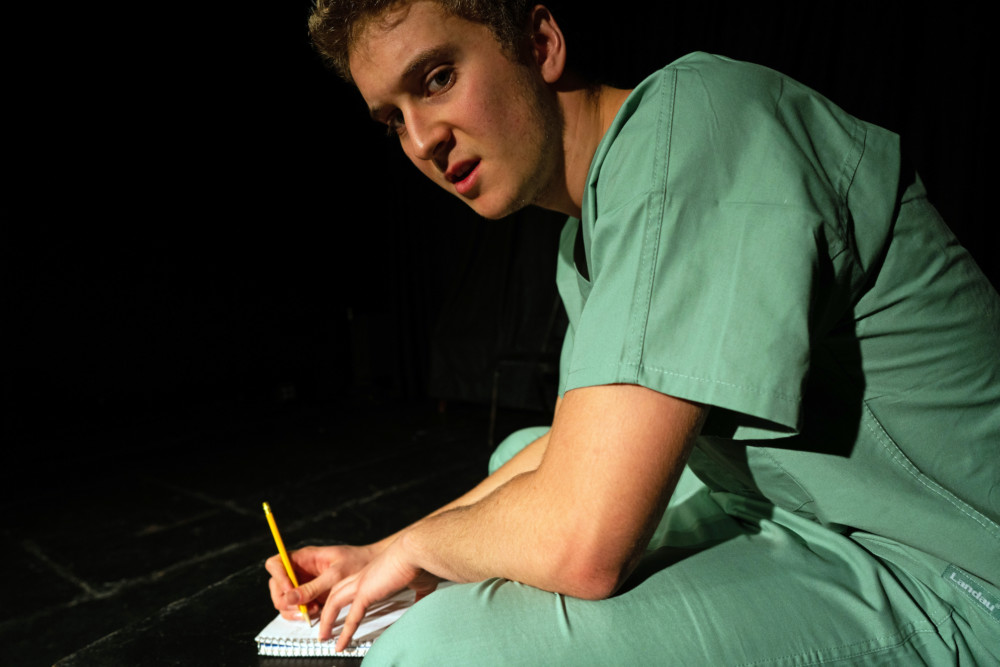
The Ensemble with Ruth Negga
By Carol Rocamora
There are three of them— huge, ghoulish men wearing bowler hats, lurking in the shadows, slipping secretively through the scenes. In the course of director Yaël Farber’s electrifying Hamlet at St. Ann’s Warehouse, you’ll see them performing various tasks— pushing gurneys with dead bodies, grave-digging, chanting, singing, even performing in the Player King’s play. Like Macbeth’s three witches, they’re harbingers of what’s to come: In this case, the terrible demise of all the leading characters. This macabre trio is one of the many ingenious strokes in Farber’s inspired production— elements that enhance the play’s central themes.
Shakespeare’s Hamlet, of course, is a play about mortality (“to be or not to be,” etc.). But I never experienced the impact of its central theme as strongly as I did while watching this revelatory Hamlet, which swept me along in a tidal wave.
That’s what makes the choice of Ruth Negga in the title role so dazzling. Negga is the most vital Hamlet I’ve ever seen— from Laurence Olivier, Nicol Williamson, Richard Burton, to Ethan Hawke, Liev Schreiber, and Benedict Cumberbatch (and so many more). Significantly, she’s the youngest— at least, in appearance.
Though slight in stature (a mere 5’3”) and boyish in demeanor, Negga brings a fiery intensity to the role that renders her twice her size. She moves the play along at a fast-and-furious pace, as scene after scene speed by. Slouching on the sidelines, she’ll suddenly spring to life and literally pounce on the next scene, her open face gleaming in the darkness, shining with passionate urgency and filled with conflicting emotions.
Negga’s tiny, lithe body fills the stage with its constantly contorted movement. She commands this production entirely, whether she’s on-stage or perched on a riser in the audience, where she delivers some of her most vital soliloquies. She’s so alive! If anyone could stave off death, this Hamlet can…


Ruth Negga
Hamlet is also a play about power. To express that theme, Farber and her designer Susan Hilferty offer a dark empty stage flanked by over a dozen doors used as entrances and exits through the shadowy corridors of Elsinore (representing who’s in and who’s out in this power-struggle-unto-death-between Hamlet, his mother, and his murderous stepfather, Claudius). Stage center, they’ve placed one throne-size chair, which these three family members claim at various moments in the production.
As for Farber’s direction, one inspired choice follows another. Early in the play, there’s the watery grave that Ophelia crosses on her way to an encounter with Hamlet, a chilling foreshadowing of her tragic drowning. There’s another unscripted moment where the ghost of Hamlet’s father lurks behind Gertrude, Hamlet’s mother, while she’s seated on that throne— a harbinger of her demise, too. Other arresting scenic elements include a billowy transparent sheet suddenly lowered over the entire stage, behind which appears the ghost of Hamlet’s father. Similarly, in the Hamlet/Gertrude “closet scene” a blood-red satin curtain is dramatically dropped, behind which Polonius will hide (and receive his fatal stab wound from Hamlet).
One of Farber’s most exciting choices is the use of audience space. Hamlet and other characters dart up and down the aisles, and the entire cast is seated midway in the house to watch the incriminating play-within-the-play.


Ger Kelly, Gerard Walsh, and Will Irvine
And what a marvelous cast it is! Owen Roe’s Claudius is one of the most formidable (and frightening) I’ve ever seen. Fiona Bell’s Gertrude matches him in strength – her closet scene and “there is a willow” speech are deeply moving. And I’ll never forget Aoife Duffin’s heartbreaking Ophelia as she descends into madness in her final, tragic scene (“there’s rosemary, that’s for remembrance.”)
Throughout this spell-binding production, there is a haunting sound of a mournful cello with an electronic underscore (designed by Tom Lane), crescendoing to the play’s terrible end. There’s also the strange chanting of the bowler-hat trio, as well as their recurrent refrain of “he is dead and gone, lady” (foreshadowing one of Ophelia’s final songs). But there is no sound more powerful than the voice of Ruth Negga— clarion-clear and unforgettable— as she utters Hamlet’s immortal words, etched forever in our collective theatergoing memory.
Photos: Teddy Wolff
Hamlet by William Shakespeare
Directed by Yaël Farber
At St. Ann’s Warehouse through March 8





















